-
垃圾渗滤液是垃圾在填埋和堆放过程中通过淋溶作用形成的污水受重力场作用流动的产物。其中不仅含有大量难以去除的水溶性有机质(dissolved organic mater,DOM),也含有许多高浓度的无机离子。有研究发现,腐殖酸是垃圾渗滤液中DOM的一种主要成分[1],由高分子的胡敏酸(humic acid,HA)和中等分子的富里酸(fulvic acid,FA)等组成,其难降解性加大了垃圾渗滤液的处理难度[2-3]。在无机离子中,除有钾离子、钠离子、硫酸根离子、硝酸根离子等离子外,还有高浓度的氨氮存在[4],由于垃圾渗滤液的长期缺氧环境,其中的氨氮难以被氧化[5]。反渗透技术(reverse osmosis, RO)一直以来都被证明是一种处理垃圾渗滤液的有效方法[6],其不仅对有机污染物有着高效的去除率,同时也能够去除绝大多数无机离子[7]。然而,反渗透进水中高浓度的有机物和无机离子往往会增大反渗透膜的负担,降低其去除效果并减少其使用寿命,大大增加垃圾渗滤液的处理成本。因此,急需新技术对垃圾渗滤液进行预处理,与反渗透技术进行组合,以提高垃圾渗滤液处理的效果。
膜电容去离子技术(membrane capacitive deionization,MCDI)是一种通过循环充放电过程来实现离子的去除和再生的技术。在充电过程中,溶液在流经电极时阴阳离子分别在电场力的作用下被不断吸附到阳极和阴极上形成双电层;在放电过程中,通过将电极反接或者短接,阴极和阳极上被吸附的离子又重新脱回到浓水中,实现阴阳极的再生[8]。离子交换膜的存在不仅能抑制与膜极性相同的离子被吸附,从而提高吸附效率,而且在脱附时极性相反的离子能够得到充分的冲洗,有效地防止共离子效应[9],使得脱附更加充分[10-11]。相较于RO技术来说,MCDI在无机离子的去除上有着更低的能耗和更好的再生效果[12-13],具有作为RO技术的预处理工艺的潜力。但在对垃圾渗滤液进行吸附除盐的应用上,MCDI技术还存在着许多难点。LIU等[14]发现腐殖酸会对活性炭造成污染和破坏,造成电化学氧化并产生二氯乙酸前体物,进而影响其对无机离子的吸附效果并产生大量污染。FANG等[15]发现氨氮会在电容去离子的吸附过程中与其他离子产生竞争关系,影响其他无机离子的吸附。
目前,MCDI技术对垃圾渗滤液中无机离子的去除效果的影响因素以及相应的机理的研究还处于空白状态,这成为MCDI技术应用于垃圾渗滤液除盐的巨大阻碍。本研究以垃圾渗滤液中典型的主要无机离子含量为参照进行人工配水,探讨了不同氨氮和腐殖酸浓度对MCDI去除模拟垃圾渗滤液中无机离子的影响。
全文HTML
-
实验试剂:硫酸铵((NH4)2SO4,分析纯)、磷酸二氢钾(KH2PO4,分析纯)、碳酸氢钠(NaHCO3,分析纯)、氯化钾(KCl,分析纯)、硝酸钾(KNO3,分析纯)、碳酸氢铵(NH4HCO3,分析纯)、硫酸钠(Na2SO4,分析纯)和腐殖酸(分析纯)。
实验仪器:数显恒温磁力加热搅拌器(群安实验仪器有限公司,HS-19),直流稳压电源(深圳科睿源科技有限公司,KA3010D),台式可见分光光度计(哈希DR3900),原子吸收光谱仪(岛津AA-7000),离子色谱仪(瑞士万通,761Compact IC),pH计测试仪(上海越平PH-3C),超声波清洗仪(深圳科洁超声科技有限公司,KJ-20AD),数显电导率仪(上海越平科学仪器有限公司,DDS-11A)。
-
装置电极的组成包括:活性交联碳布(activated woven carbon cloth,FM10,chemviron carbon cloth division,UK);PE阴阳离子交换膜(苯乙烯磺酸型阳离子交换膜,苯乙烯季铵型阴离子交换膜,杭州绿合环保有限公司);泡沫镍(250 mm×250 mm×0.3 mm);亚克力板(250 mm×250 mm×5 mm),东莞市马良橡塑制品有限公司;硅胶垫(250 mm×250 mm×0.2 mm)。实验装置主要由MCDI电极、进水槽、蠕动泵、恒压电源和流量计等组成,如图1所示。
-
为考察氨氮和腐殖酸对模拟垃圾渗滤液中无机离子去除的影响,实验开始前,首先采用试剂配制了9种250 mL的垃圾渗滤液模拟溶液各3瓶,其成分如表1所示。实验用水为去离子水。
实验开始时,首先设置MCDI的流量为20 mL·min−1,电压为1.2 V,然后对每种模拟垃圾渗滤液进行3个周期的单通道吸附过程。在每个吸附周期之后,用去离子水对MCDI进行脱附,直到电导率不再升高。3次吸附周期完成后,进行离子交换膜和活性炭布的超声波清洗过程。
-
待测数据包括9种模拟垃圾渗滤液的配制液和3次循环中吸附后的处理液的Na+、K+、
NH+4 、Cl−、SO2−4 、NO−3 的浓度以及pH和UV254。测定之前,先将所有待测样用水相针式过滤器(13 mm×0.45 μm)进行过滤。Na+和K+的浓度依据GB 11904-1989,采用岛津AA-7000原子吸收光谱仪进行测定。NH+4 和SO2−4 的浓度依据《哈希常用试剂方法》,采用哈希DR3900台式可见分光光度计测定。Cl−和NO−3 分别依据GB 11896-1989和《水和废水监测分析方法(第4版)》,采用离子色谱仪进行测定,色谱柱型号为Super7,进样方式为自动进样。pH采用pH计测试仪进行测定,UV254采用Cary8454紫外分光光度计进行测定,以吸光度作为腐殖酸的浓度的替代参数。在组装MCDI装置前,将ACC在100 ℃下进行24 h的烘干,以平均离子吸附量来表征MCDI对离子的吸附效果,其计算方法如式(1)所示。
式中:αi是i离子(i为Na+、K+、NH4+、Cl−、
SO2−4 和NO−3 )的平均离子吸附量,mg·g−1;ci0与cit分别是i离子在原液中和吸附后的浓度,mg·L−1;V为模拟垃圾渗滤液的体积,mL;m为单片活性炭布的质量,g。通常,腐殖酸主要是腐殖酸(胡敏酸)、富里酸(黄腐酸)和腐殖素(胡敏素)的统称,其中各成分的溶解性随着溶液pH的变化有较大的差异[16]。由于DOMs在254 nm的波长处有吸收,故国内外通常采用UV254作为评价腐殖酸在内的DOMs总量的重要指标[17]。本研究采用人工配水,DOMs中仅包含腐殖酸,因此,采用UV254直接表征溶液中腐殖酸浓度,用UV254的去除率表征溶液中腐殖酸的去除效果,计算方法如式(2)所示。
式中:β为腐殖酸的去除率;λ0和λt分别为模拟垃圾渗滤液原液和经MCDI处理后在254 nm处的吸光度。
1.1. 实验试剂与仪器
1.2. 实验装置
1.3. 实验方法
1.4. 分析方法
-
1) 氨氮对阳离子的吸附效果的影响。图2列出了不同浓度氨氮下,MCDI装置对模拟垃圾渗滤液中Na+、K+、
NO−3 的吸附效果。与模拟垃圾渗滤液A0相比,B1、B2、B3和B4的氨氮吸附量分别增大了58.17%、79.27%、105.65%和109.37%。可以看出,当初始氨氮浓度从535.21 mg·L−1(A0)提高到875.66 mg·L−1(B3)时,α(NH+4 )迅速增加,然而与B4和B3相比,α(NH+4 )并未发生太大改变。这可能是因为较高的离子浓度会产生更强的驱动力,促使离子穿透离子交换膜与ACC接触[18],此外,根据离子的吸附动力学,在一定范围内,离子的吸附量与其浓度为正相关的关系[19]。但当氨氮浓度过高时,一方面受ACC上的吸附位点的限制,其吸附速度已经达到了极限;另一方面,离子浓度过高会造成电流效率的降低,同离子的积累将增大离子间的排斥效应,使得多余的离子更难以被ACC吸附[20]。从图2还可以看出,MCDI对于阳离子的吸附量大小顺序为α(NH4+)>α(K+)>α(Na+)。K+和Na+的吸附量由于初始氨氮浓度的升高而降低,当氨氮浓度升高到875.66 mg·L−1(B4)时,2种离子的吸附量开始迅速下降,α(Na+)的下降的程度(最高65.13%)要大于α(K+)(最高为47.48%)。这是由于
NH+4 、Na+和K+在被MCDI的阴极吸附时具有离子选择效应,该效应受到离子的水力半径和离子扩散系数等因素的影响[21-22]。离子水合作用指的是离子和水分子之间的静电作用,属于离子-偶极作用。当离子进入水中时,这种静电作用就使水分子朝离子围拢过来,最终使水分子与离子以特定的方式结合,即以离子对的形式或水分子包围离子的形式。离子电荷强度将会受到极性水分子的静电屏蔽(electrostatic screening)作用的影响,当离子的水合半径越大时,这种静电屏蔽效应越强烈,离子被MCDI的电场的吸附效果越弱[23]。另外,离子在膜上的扩散通量是影响MCDI对离子吸附效果的另一因素,Nernst-Planck方程[24-25]很好地描述了这种关系(见式(3))。式中:Ji为i离子在膜上的通量,mmol·(s·cm2)−1;Di为离子扩散系数,cm2·s−1;zi为离子的价态;ci为离子的浓度,mmol·cm−3;gradci和gradΦ分别为离子的浓度梯度和电势梯度。
鉴于模拟垃圾渗滤液中,离子在MCDI的流道中将发生密集的流体混合,在隔离物上呈现低浓度分布,因此,忽略离子的浓度梯度gradci对离子通量的影响[26]。此外,本研究拟定当施加1.2 V的电压时,MCDI阴阳极双电层结构是对称的[27],结合式(3)可以推断i离子和j离子在离子交换膜上的通量Ji和Jj的比值应该遵循式(4)。
结合表2和式(4),垃圾渗滤液中3种阳离子初始离子通量关系为
JNH+4 >JK+>JNa+,在垃圾渗滤液A0中,JNa∶JK∶JNH+4 =1∶1.87∶3.61;同时,离子的水合半径大小为RNa+ >RK+ =RNH+4 。由于Na+在3种阳离子中有最大的水合半径和最小的离子通量,故吸附量最低。尽管NH+4 和K+在水合半径上是一致的,但NH+4 比K+的水化率低,因而3种离子在MCDI的选择竞争性应该为NH+4 >K+>Na+,且Na+由于水化率和水合半径的关系受到NH+4 竞争的影响要大于K+。2) 氨氮对阴离子的吸附效果的影响。图3列出了不同浓度的氨氮下MCDI装置对模拟垃圾渗滤液中Cl−、
SO2−4 和NO−3 等3种离子的吸附结果。可以看出,SO2−4 的吸附量要显著高于Cl−和NO−3 。这可能归因于以下2个方面:首先,2种离子所带的电荷数不同,这将取代离子的水合半径成为影响离子吸附效果的主要因素,尽管从水合半径来看,RSO2−4 大于RCl− 和RNO−3 (表2),但二价离子的有效电荷量仍然高于一价离子[23];其次,模拟垃圾渗滤液中SO2−4 的初始浓度显著高于Cl−和NO−3 (表1),从式(4)可以计算出3种阴离子的初始离子通量关系为JSO2−4 >>JNO−3 >JCl−。由横向比较的结果可以看出,α(
SO2−4 )随着模拟垃圾渗滤液中氨氮浓度的升高而显著下降,相比模拟垃圾渗滤液A0,B1~B4的α(SO2−4 )分别下降了6.79%、18.28%、29.74%和35.25%,但α(Cl−)和α(NO−3 )的变化趋势则不明显。这是因为RSO2−4 比RCl−和RNO−3 更高,SO2−4 受到NH+4 的竞争影响最大,吸附量下降得最快,此时由于两极电荷平衡的影响,α(Cl−)和α(NO−3 )反而会有所升高(A0、B1、B2)。从表2可以看出,尽管NO−3 与Cl−在水合半径和扩散系数上差别不大,但由于Cl−的水化率要显著高于NO−3 ,因此,Cl−受到NH+4 竞争的影响大于NO−3 ,在氨氮浓度过高时,α(Cl−)也会开始下降(B2、B3、B4)。 -
1) 腐殖酸对阳离子的吸附效果的影响。图4(a)列出了不同浓度的腐殖酸下,模拟垃圾渗滤液中Na+、K+、
NH+4 的吸附效果。可以看出,与模拟垃圾渗滤液A0相比,C1和C2的α(K+)和α(NH+4 )均有所上升。因为腐殖酸本身偏酸性,腐殖酸浓度的升高会使溶液的pH降低(图4(c))。当模拟垃圾渗滤液的初始pH从7.83(A0)下降到7.2(C2)时,由于电离平衡,NH3分子逐渐结合水中的H+变成NH+4 ,从而导致离子交换膜电势的升高,使得NH+4 的吸附量升高[28-31]。同时,腐殖酸中的酚类官能团和羧基能够与氨氮结合,形成化合物,这也促进了NH+4 的吸附[32]。对金属离子来说,部分金属离子容易与腐殖酸中的羧酸基团结合形成金属-腐殖酸化合物(metal-humic complex,MHC)[33],这种作用将促进彼此在溶液中的吸附作用,但不同的金属离子促进作用不同,K+与腐殖酸结合的能力大于Na+[34]。由于腐殖酸本身是疏水性最大的物质之一[34],而3种阳离子的水化率为NH+4 >K+>Na+,因此,Na+与腐殖酸的结合能力最弱,在腐殖酸的浓度增加时(Na+)一直处于下降趋势。当腐殖酸浓度继续上升时,3种阳离子的吸附量则都呈现下降的趋势。相比A0,C4的α(
NH+4 )、α(K+)和α(Na+)分别达到7.88%、19.79%和34.28%。由图4(c)看出,模拟垃圾渗滤液经过MCDI吸附之后,pH均上升了,且随着腐殖酸浓度的上升,吸附前后pH的差值也会升高,说明MCDI会吸附溶液中部分H+,将与其他阳离子的吸附产生竞争效应,腐殖酸的浓度越高,H+的浓度也越高,这种竞争效应也就越强,因此,最终3种阳离子的吸附量均会因为腐殖酸含量的升高而降低。2) 腐殖酸对阴离子的吸附效果的影响。图4(b)列出了不同浓度的腐殖酸下,模拟垃圾渗滤液中Cl−、
SO2−4 、NO−3 的吸附效果。与阳离子不同的是,当腐殖酸浓度升高后,阴离子的吸附量均会呈现更大程度的下降。这可能是因为腐殖酸HA中的酸根离子A−主要由MCDI的阳极吸附,其竞争效应比H+更加强烈。与α(NO−3 )相比,α(SO2−4 )和α(Cl−)衰减程度更大,其中,α(SO2−4 )在腐殖酸浓度不太高的C1和C2就有了相当程度的衰减,分别为14.88%和31.33%;当腐殖酸浓度继续升高时,α(Cl−)的衰减程度开始剧烈增加,模拟垃圾渗滤液C4的α(Cl−)、α(SO2−4 )和α(NO−3 )相比A0分别衰减了72.12%、63.45%和21.46%。这是由于垃圾渗滤液中SO2−4 的初始浓度显著高于另外2种阴离子,因而其吸附量的衰减较为明显;而Cl−的水化率要显著高于其他2种离子(表2),尽管Cl−的浓度在模拟垃圾渗滤液中较其他2种离子更低,但随着腐殖酸浓度的升高,其衰减程度最大。NO−3 在3种离子中具有疏水性大、水合半径小和扩散系数大的特点,受到腐殖酸浓度升高的影响最小,在腐殖酸浓度较高时,也有较好的去除效果。 -
1) 多个吸附循环后MCDI对腐殖酸的吸附。尽管适量腐殖酸的加入会使MCDI对部分无机离子的吸附量增大,但其可能带来的有机污染问题仍是MCDI技术应用于垃圾渗滤液脱盐的一个挑战。图5是3个吸附周期内,MCDI对垃圾渗漏液中腐殖酸的吸附结果。可以看到,在第1个周期内,模拟垃圾渗滤液中腐殖酸的去除率β可以达到74.84%(C1)、64.59%(C2)、62.5%(C3)和47.4%(C4)。这里除了MCDI的吸附作用外,溶液中的阳离子与模拟垃圾渗滤液结合形成MHC也促进了腐殖酸的吸附。然而在第2和第3个周期,β迅速下降,这是因为MCDI的吸附主要包括2个过程,即物理吸附(非极性吸附)和电吸附(极性吸附)。对于腐殖酸这种非极性的疏水性物质来说,在这种环境下,腐殖酸会形成胶态物质,其带电量很少且能在不施加电场的情况下被吸附,因而物理吸附(非极性吸附)起到主要作用[35]。此外,与电吸附相比,物理吸附难以采用短接或者反接电极等方式脱附下来[9]。因此,大量在第1个周期中因物理吸附作用被吸附的腐殖酸残留在电极上,降低了MCDI对腐殖酸的再吸附能力;同时,腐殖酸的存在将与溶液中的离子结合,在离子交换膜表面形成一层致密污染层(dense fouling layer,DFL),这种污染层将大大增加离子通过离子交换膜的阻力,这不仅降低离子的吸附效果,并且在脱附时也会导致离子的脱附不完全。随着模拟垃圾渗滤液中腐殖酸的浓度升高,这种污染程度将更加严重。
2) 多个吸附循环后MCDI对离子的吸附。图6是在3个循环吸附周期下,含有不同浓度腐殖酸的垃圾渗滤液的吸附结果。可以看出,在不含腐殖酸的A0中,3个周期内6种无机离子的吸附量会在误差范围内上下波动;而模拟垃圾渗滤液C1~C4在第2周期和第3周期,阳离子的吸附量均相较于第1个周期呈现不同程度的下降,且这种下降程度随着垃圾渗滤液中初始浓度的升高而更加明显。除了2.2节提到的腐殖酸中H+的竞争效应之外,脱附效率的降低也是重要原因。经过第1个周期的吸附之后,大量腐殖酸没有从活性交联碳布上脱附下来,且部分腐殖酸由于其疏水性而附着在疏水性的离子交换膜上,因而导致离子交换膜的交换通量和活性交联碳布的比表面积下降,这也会减少其他离子的解吸附效率,从而进一步导致后续周期中离子的再吸附效果的下降。α(
NH+4 )在后面第2周期和第3周期中衰减最大,α(Na+)其次,而α(K+)最小。在垃圾渗滤液C4中,α(NH+4 )的衰减达到69.61%和73.28%,α(Na+)比第1周期分别下降了72.29%和57.05%,而α(K+)仅为46.61%和35.36%。这可能是因为NH+4 的浓度远高于其他2个离子(表1),由于Na+水合半径较大,扩散系数较小(表2),因而当膜通量减少时,这2个离子受到了更大的影响,吸附量衰减较大。与阳离子不同,当腐殖酸浓度较低时(C1和C2),第2周期和第3周期的α(
SO2−4 )相比第1个周期的下降幅度较大,最高达到48.29%,这同样是因为离子交换膜的膜通量和活性交联碳布的比表面积减少的缘故;而在第2周期和第3周期,C3中的α(SO2−4 )分别下降了17.05%和18.43%,C4中的下降了17.86%和9.29%。这可能是因为当腐殖酸浓度较高时,相比腐殖酸对膜孔和活性交联碳布微孔的堵塞作用来说,腐殖酸中的阴离子与SO2−4 的竞争作用在抑制其吸附时起到更主要的作用,因此,在C3和C4中,在第1周期,α (SO2−4 )已经由于腐殖酸的离子竞争作用而大大减少,到了第2周期和第3周期,其吸附量下降的程度反而不明显了。同样Cl−因为水化率较高,在第1周期的吸附量因为腐殖酸中阴离子的竞争效应而大大降低,因此,在后2个周期中,α(Cl−)相比第1个周期基本没有降低。而NO−3 由于受到腐殖酸中阴离子的竞争效应的影响较低,因此,堵塞效应成为其吸附量减少的主要原因,α(NO−3 )在第2周期和第3周期中的下降更加明显。
2.1. 氨氮对MCDI吸附效果的影响
2.2. 腐殖酸对MCDI吸附效果的影响
2.3. 腐殖酸对MCDI污染程度的探讨
-
1)模拟垃圾渗滤液中的氨氮浓度升高会增大MCDI对氨氮的吸附量,最高可达4.38 mg·g−1。但其他离子的吸附量则会降低,阳离子吸附量衰减程度为Na+>K+,阴离子中吸附量衰减程度为
SO2−4 显著高于Cl−和NO−3 。2)少量腐殖酸(<1 500 mg·L−1)存在时,NH4+和K+的吸附量会略微上升,最高可达37.92%和14.19%。但当腐殖酸浓度过高时,6种无机离子的吸附量均会下降,其中
SO2−4 、NO−3 和Na+吸附量衰减较为明显,最高分别达到72.12%、63.45%和34.28%。同时经过多个循环后,大量腐殖酸会残留在电极上无法脱附下来,导致后续周期MCDI对离子和腐殖酸的吸附量降低,影响MCDI的寿命。3)与模拟的垃圾渗滤液相比,实际的垃圾渗滤液有机成分和无机成分更加复杂,因此,本研究的结论还须采用实际的垃圾渗滤液进行验证。








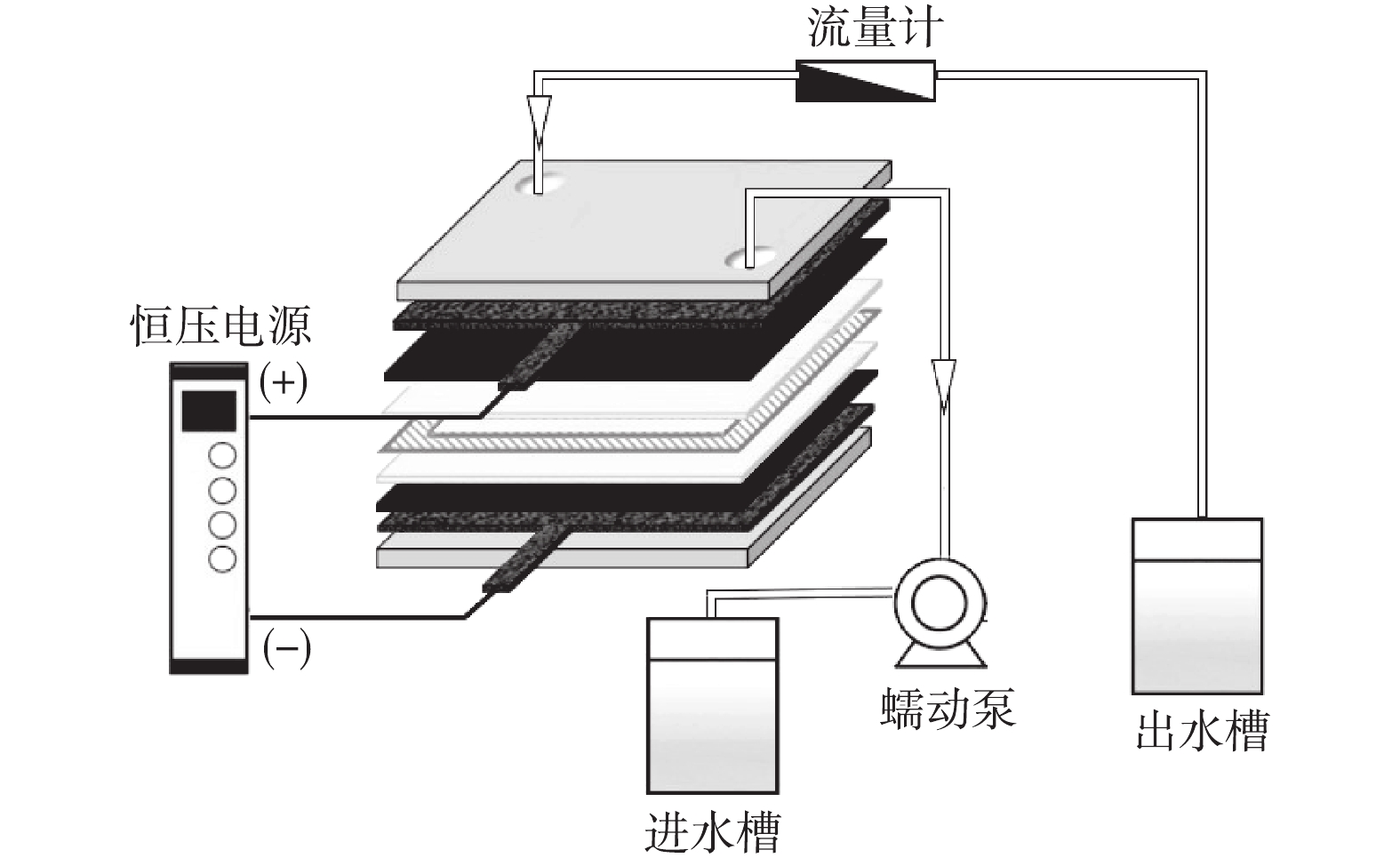
 下载:
下载:
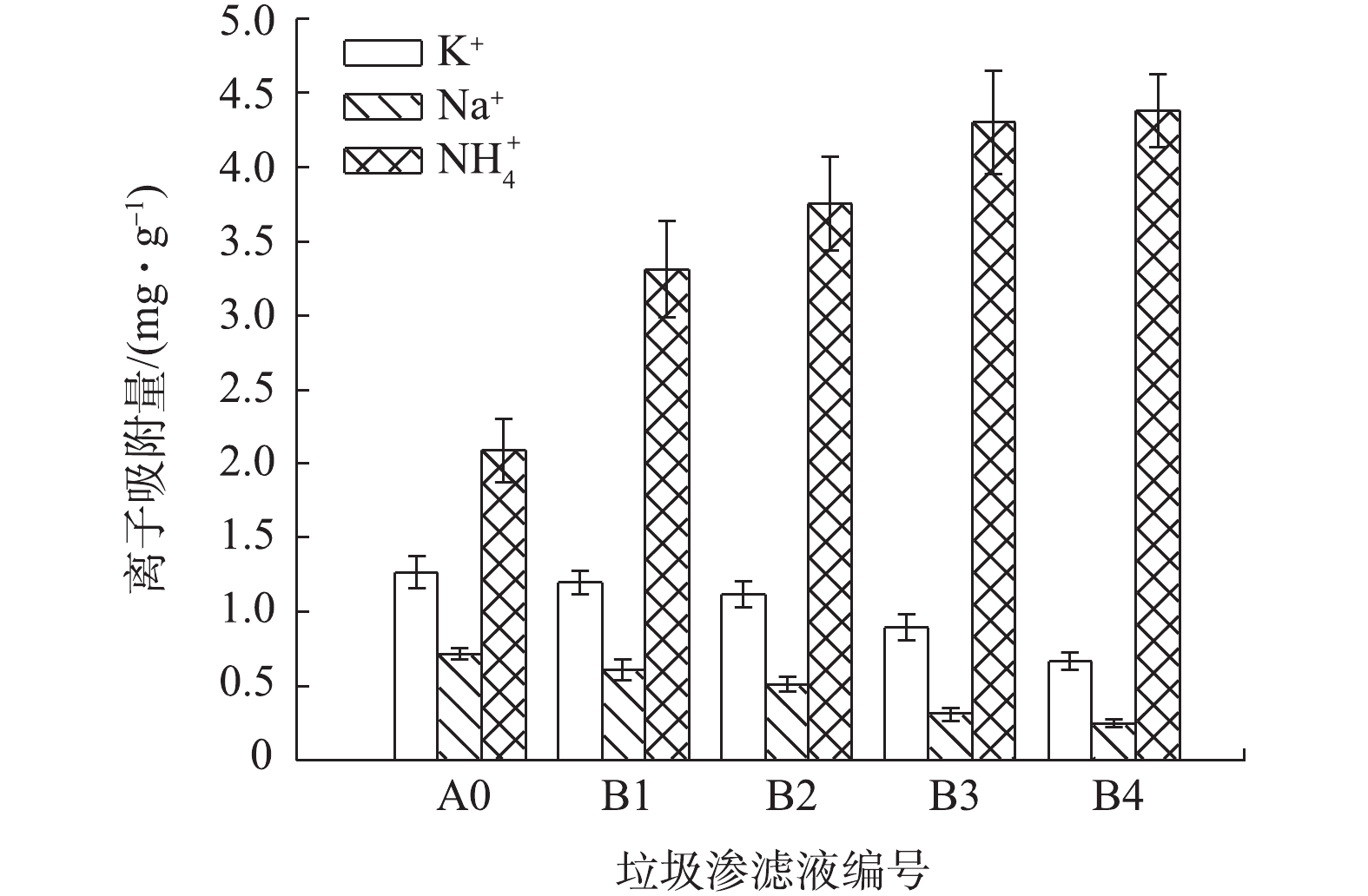
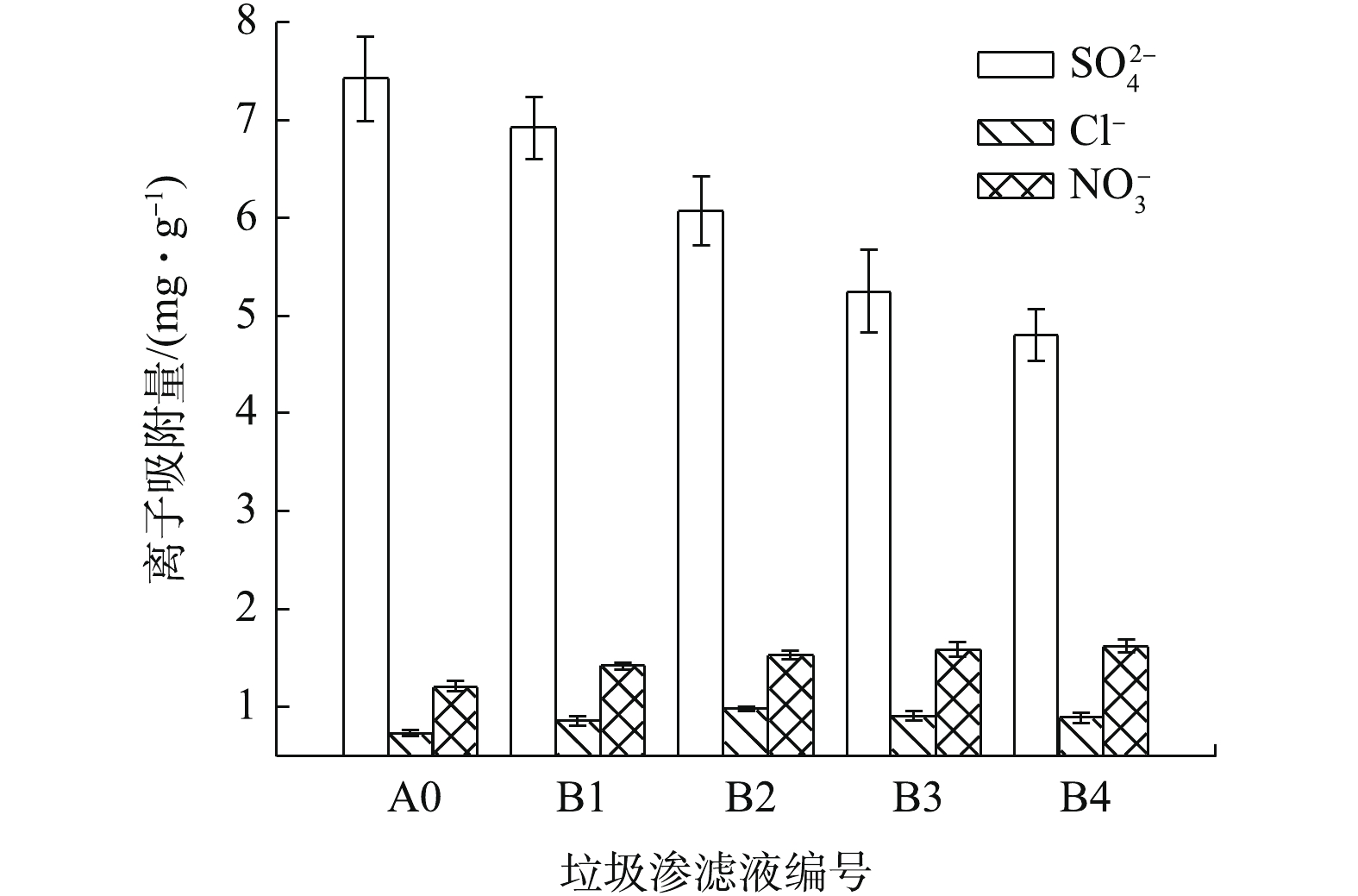

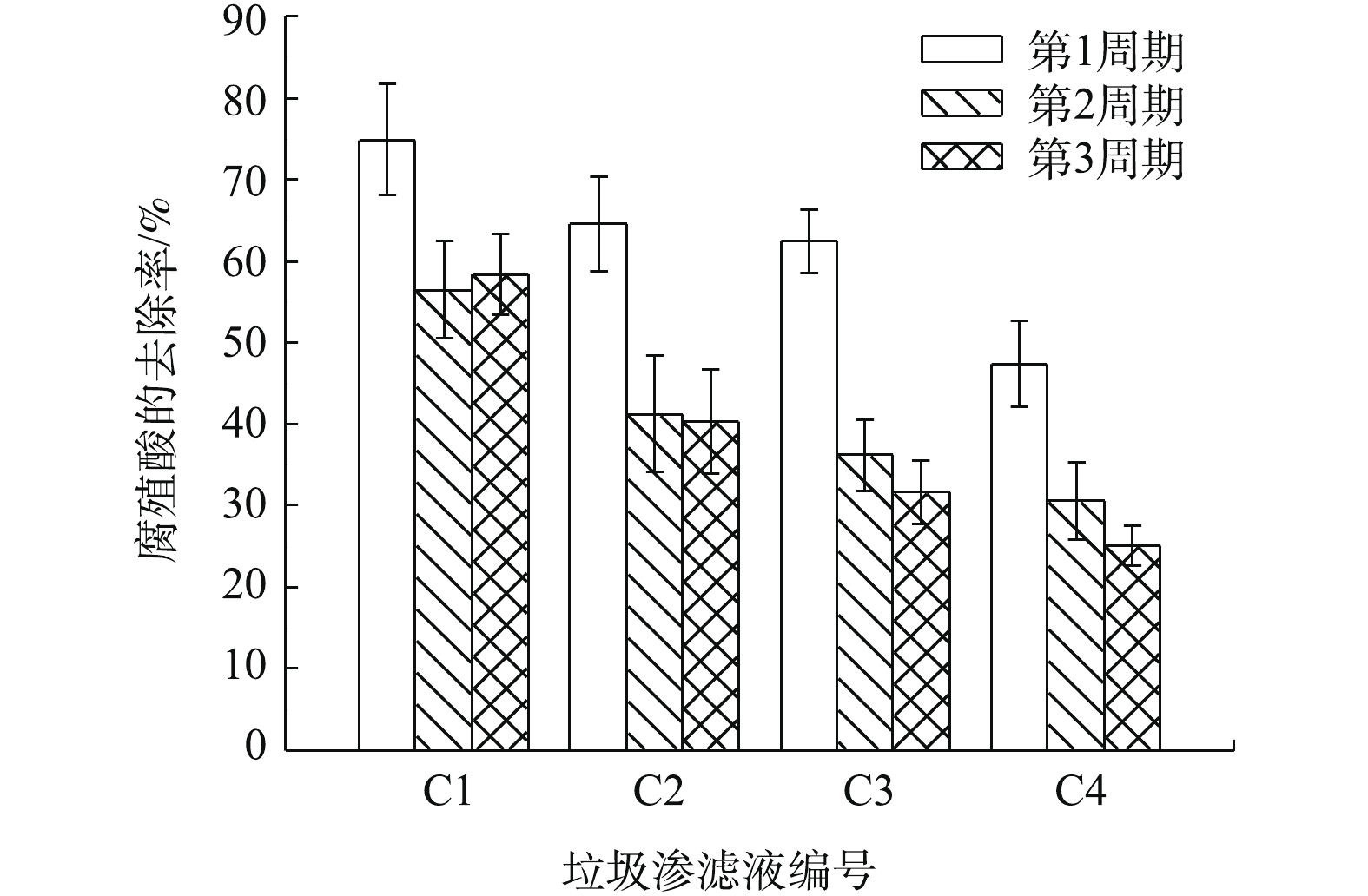
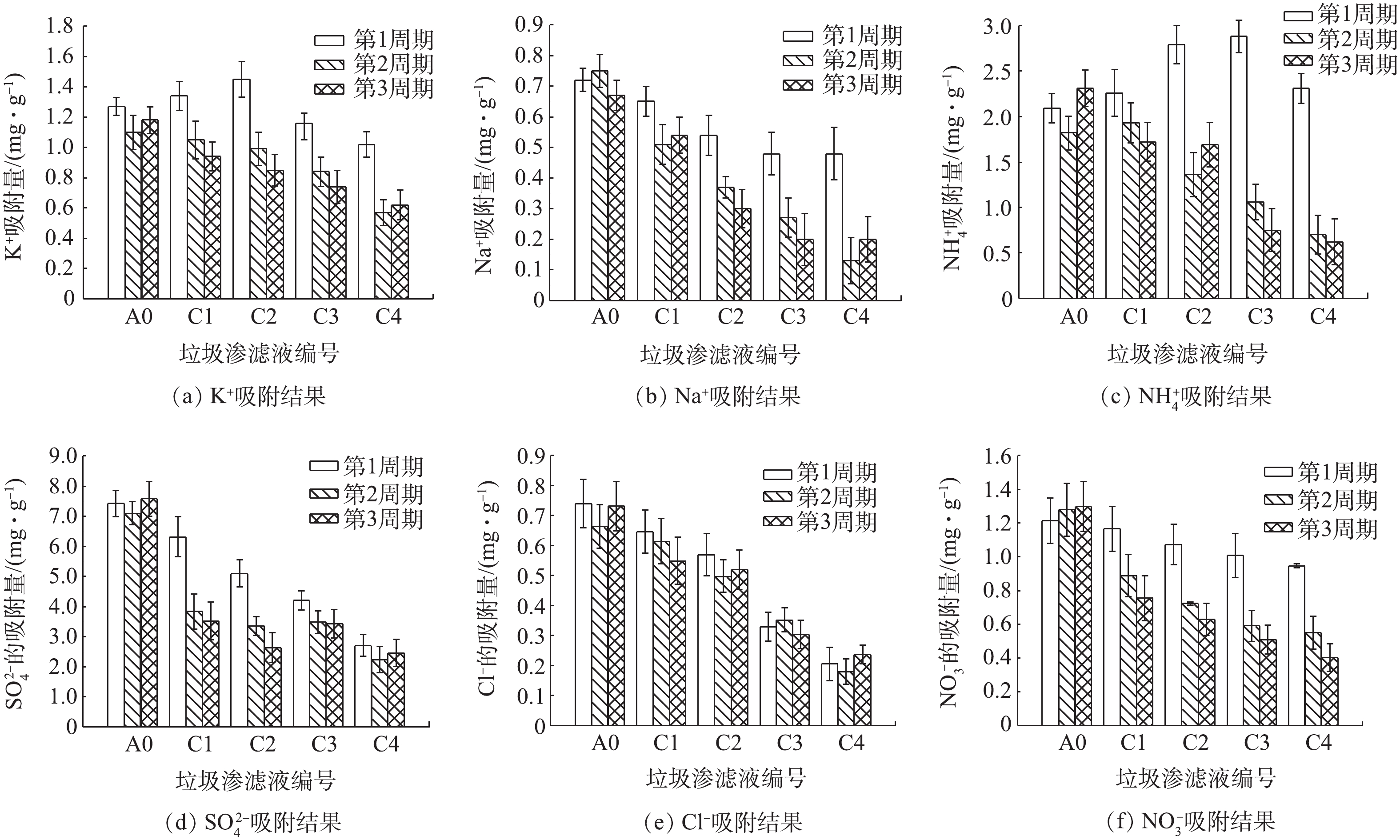
 百度学术
百度学术





